1993 CHEVROLET ASTRO PASSENGER trailer
[x] Cancel search: trailerPage 58 of 345
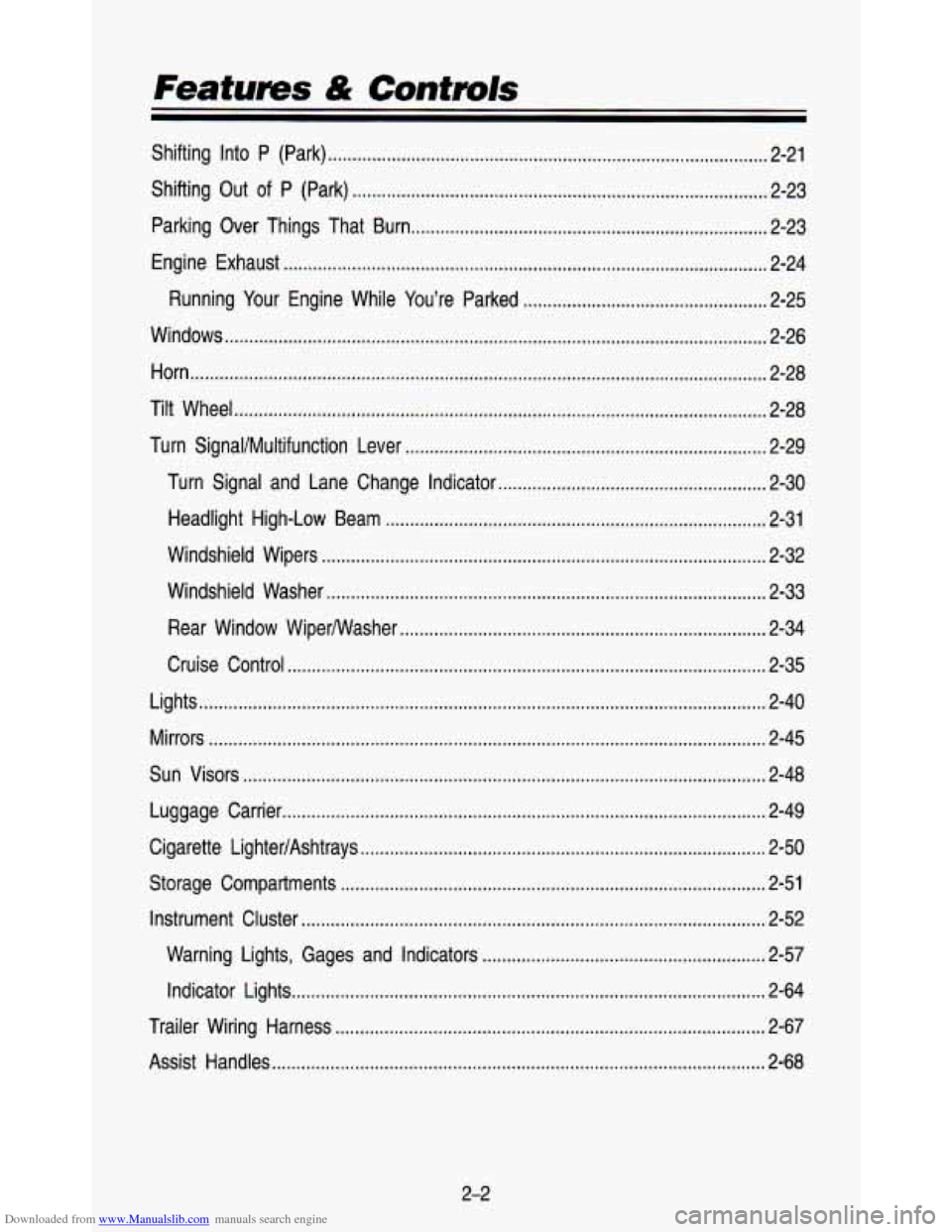
Downloaded from www.Manualslib.com manuals search engine Features & Controls
Shifting Into P (Park) ........................................................................\
.................. 2-21
Shifting Out
of P (Park) ........................................................................\
............. 2-23
Parking Over Things That Burn
........................................................................\
. 2-23
Engine Exhaust
........................................................................\
........................... 2-24
Running Your Engine While You’re Parked
.................................................. 2-25
Windows
........................................................................\
....................................... 2-26
Horn
........................................................................\
.............................................. 2-28
Tilt Wheel
........................................................................\
..................................... 2-28
Turn Signal/MuItifunction Lever
........................................................................\
.. 2-29
Turn Signal and Lane Change Indicator
....................................................... 2-30
Headlight High-Low Beam
........................................................................\
...... 2-31
Windshield Wipers
........................................................................\
................... 2-32
Windshield Washer
........................................................................\
.................. 2-33
Rear Window WiperNVasher
........................................................................\
... 2-34
Cruise Control
........................................................................\
.......................... 2-35
Lights
........................................................................\
............................................ 2-40
Mirrors
........................................................................\
.......................................... 2-45
Sun Visors
........................................................................\
................................... 2-48
Luggage Carrier
........................................................................\
........................... 2-49
Cigarette Lighter/Ashtrays
........................................................................\
........... 2-50
Storage Compartments
........................................................................\
............... 2-51
Instrument Cluster
........................................................................\
....................... 2-52
Warning Lights, Gages and Indicators
.......................................................... 2-57
Indicator Lights
........................................................................\
......................... 2-64
Trailer Wiring Harness
........................................................................\
................ 2-67
Assist Handles
........................................................................\
............................. 2-68
2-2
Page 74 of 345
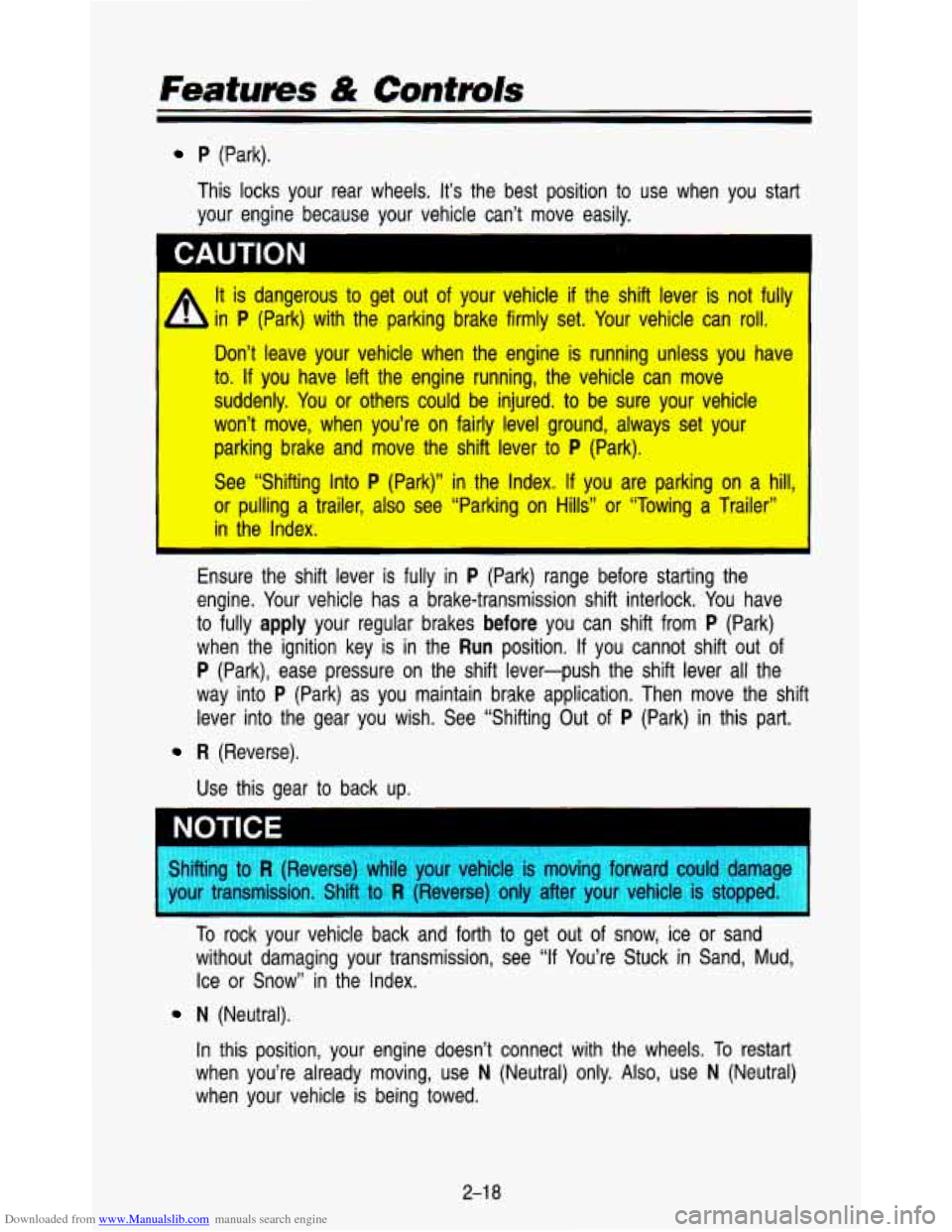
Downloaded from www.Manualslib.com manuals search engine P (Park).
This locks your rear wheels.
It’s the best position to use when you start
your engine because your vehicle can’t move easily.
WTION
It is dangerous to get out of your vehicle if the shift lever is not -fully
in
P (Park) with the parking brake firmly set. Your vehicle can roll. .
Don’t leave your vehicle when the engine is running unless you have
to.
If you have left the engine running, the vehicle can move
suddenly. You
or others could be injured. to be sure your vehicle
won’t move, when you’re on fairly level ground, always set your
parking brake and move the shift lever
to P (Park).
See “Shifting Into
P (Park)” in the Index. If you are parking on a hill:
or pulling a trailer, also see “Parking on Hills” or “Towing a Trailer”
in the Index.
Ensure the shift lever is fully in
P (Park) range before starting the
engine. Your vehicle has a brake-transmission shift interlock. You have
to fully
apply your regular brakes before you can shift from P (Park)
when the ignition key is in the
Run position. If you cannot shift out of
P (Park), ease pressure on the shift lever-push the shift lever\
all the
way into
P (Park) as you maintain brake application. Then move the shift\
lever into the gear you wish. See “Shifting Out of
P (Park) in this part.
R (Reverse).
Use this gear to back up.
I
Shifting to R (Reverse) while your vehicle is moving forward could dama--
your transmission. Shift
to R (Reverse) only after your vehicle is stoppec
To rock your vehicle back and forth to get out of snow, ice or sand
without damaging your transmission, see
“If You’re Stuck in Sand, Mud,
Ice or Snow” in the Index.
N (Neutral).
In this position, your engine doesn’t connect with the wheels.
To restart
when you’re already moving, use
N (Neutral) only. Also, use N (Neutral)
when your vehicle
is being towed.
2-1 8
Page 75 of 345
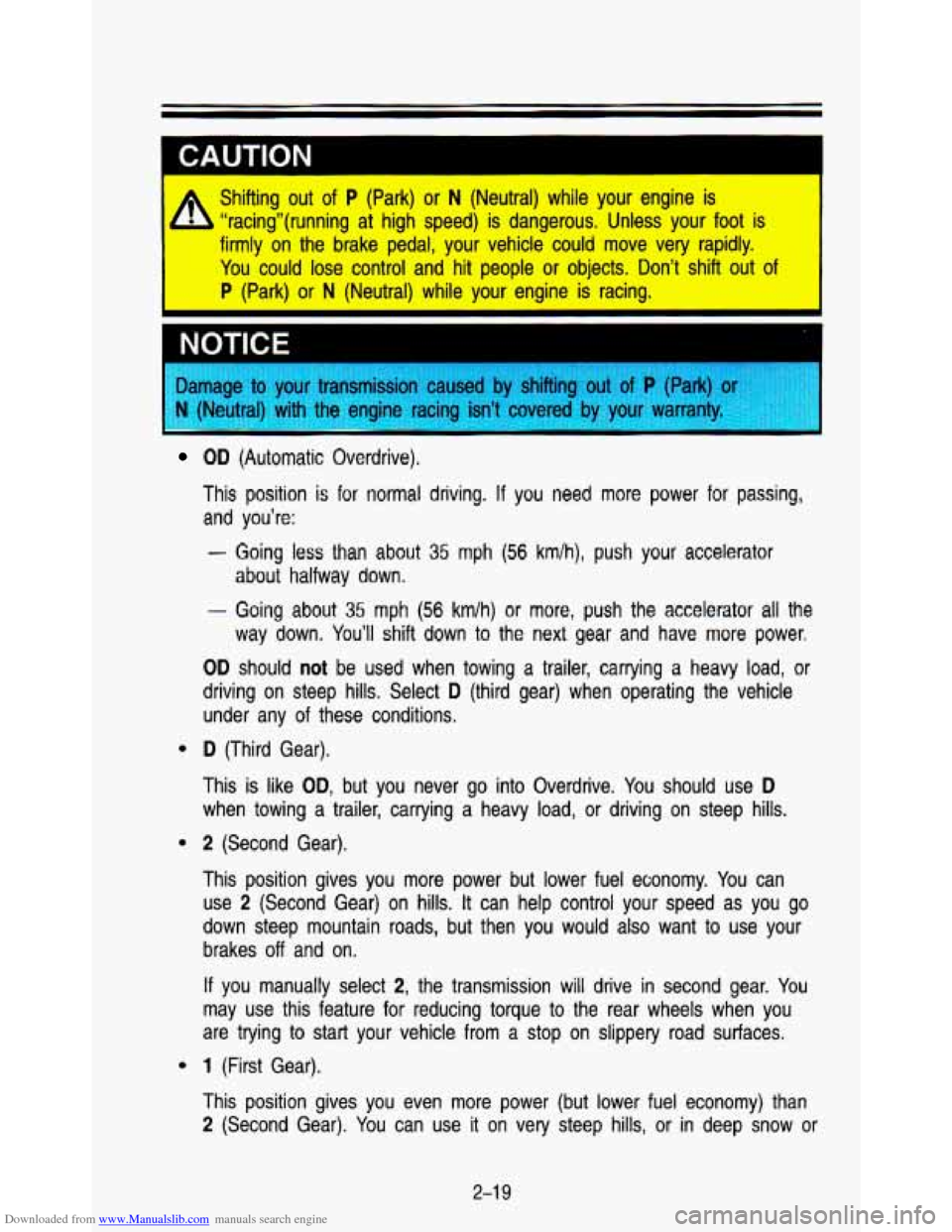
Downloaded from www.Manualslib.com manuals search engine CAUTION
Shifting out of P (Park) or N (Neutral) while your engine is
b “racing”(running at high speed) is dangerous. Unless your\
foot is
firmly on the brake pedal, your vehicle could move very rapidl\
y.
You could lose control and hit people or objects. Don’t shift out
of
P (Park) or N (Neutral) while your engine is racing.
NOTICE
sed by shifting out of P (Park) (
g isn’t covered I . .. . . . . . by . , . ..I. your , , , , warranty. , ., , ; s,L ., ... . , I . ::: :,.:. ’ .. ’., ; , : , .. . .: .. . , .. , , , . . . , .,
e
e
e
OD (Automatic Overdrive).
This position is for normal driving. If you need more power for passing,
and you’re:
- Going less than about 35 mph (56 km/h), push your accelerator
about halfway down,
- Going about 35 mph (56 km/h) or more, push the accelerator all the
way down. You’ll shift down to the next gear and have more power.
OD should not be used when towing a trailer, carrying a heavy load, or
driving on steep hills. Select
D (third gear) when operating the vehicle
under any of these conditions.
D (Third Gear).
This
is like OD, but you never go into Overdrive. You should use D
when towing a trailer, carrying a heavy load, or driving on steep hills.
2 (Second Gear).
This position gives you more power but lower fuel economy. You can
use
2 (Second Gear) on hills. It can help control your speed as you go
down steep mountain roads, but then you would also want to use your
brakes
off and on.
If you manually select 2, the transmission will drive in second gear. You
may use this feature
for reducing torque to the rear wheels when you
are trying to start your vehicle from
a stop on slippery road surfaces.
1 (First Gear).
This position gives you even more power (but lower fuel econo\
my) than
2 (Second Gear). You can use it on very steep hills, or in deep snow or
2-1 9
Page 77 of 345
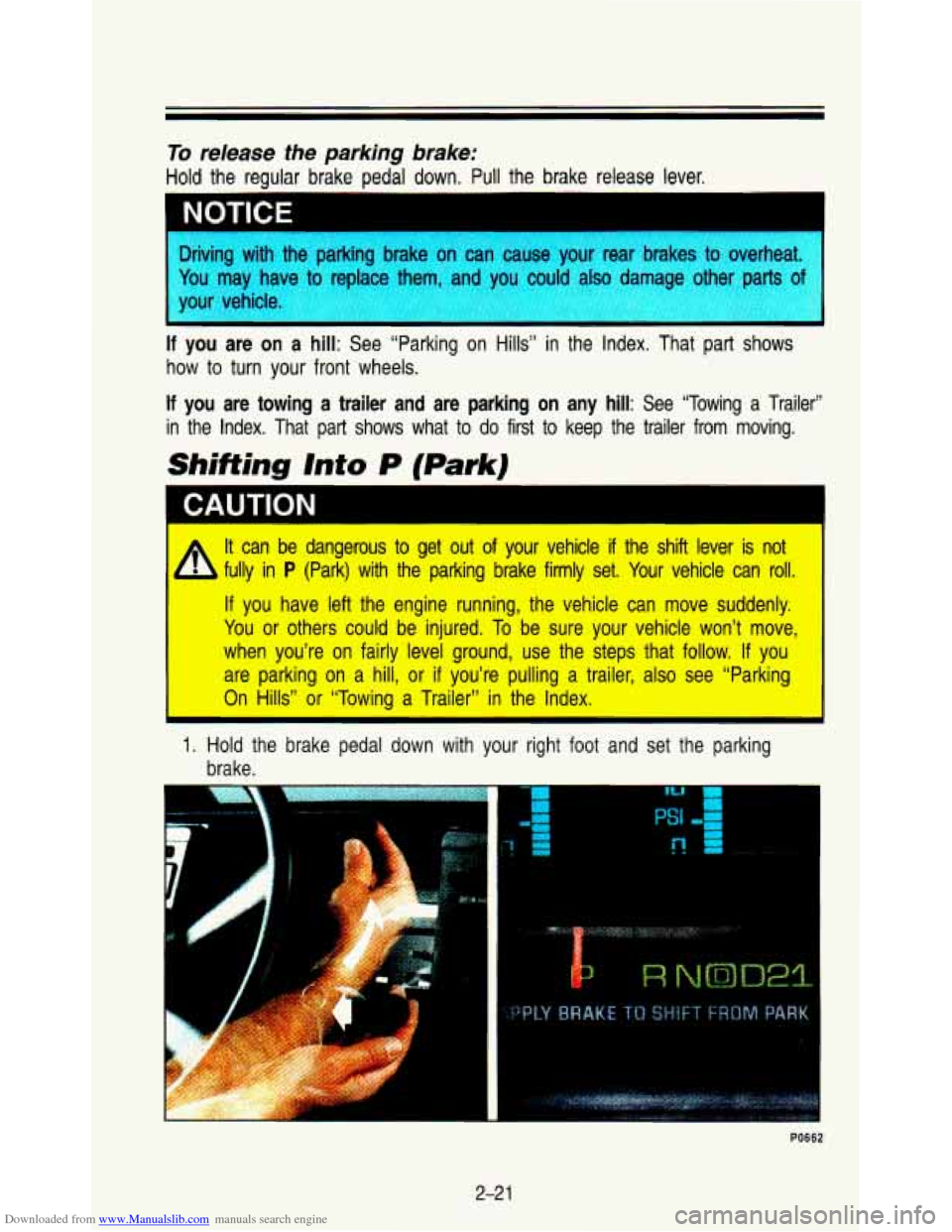
Downloaded from www.Manualslib.com manuals search engine To release the parking brake:
Hold the regular brake pedal down. Pull the brake release lever.
I NOTICE -1
, ,arking brakL
in ronlnro thorn ar
hiving .Ah thc , ,Pwe your real ,rakes to nverheal.
‘ou may ha
‘our vehicle.
- -
If you are on a hill: See “Parking on Hills” in the Index. That part shows
how to turn your front wheels.
If you are towing a trailer and are parking on any hill: See “Towing a Trailer”
in the Index. That part shows what to do first to keep the \
trailer from moving.
Shifting Into P (Park)
A It can be dangerous’to get out of your vehicle if the shift lever is not
b fully in P (Park) with the parking brake firmly set. Your vehicle can roll.
If you have left the-engine running, the vehicle can move suddenly.
You or others
could be injured. To be sure your vehicle won’t-:.rnove,
when you’re on
faiily level ground, use the steps that follow. If you
are parking
on $:hi!!, or if you’re pulling’ a trailer, also see “P;a.rking
On Hills” or “Towing a Trailer” in the Index.
1. Hold the brake pedal down with your right foot and set the parking\
brake.
F“
2-2 1
Page 81 of 345
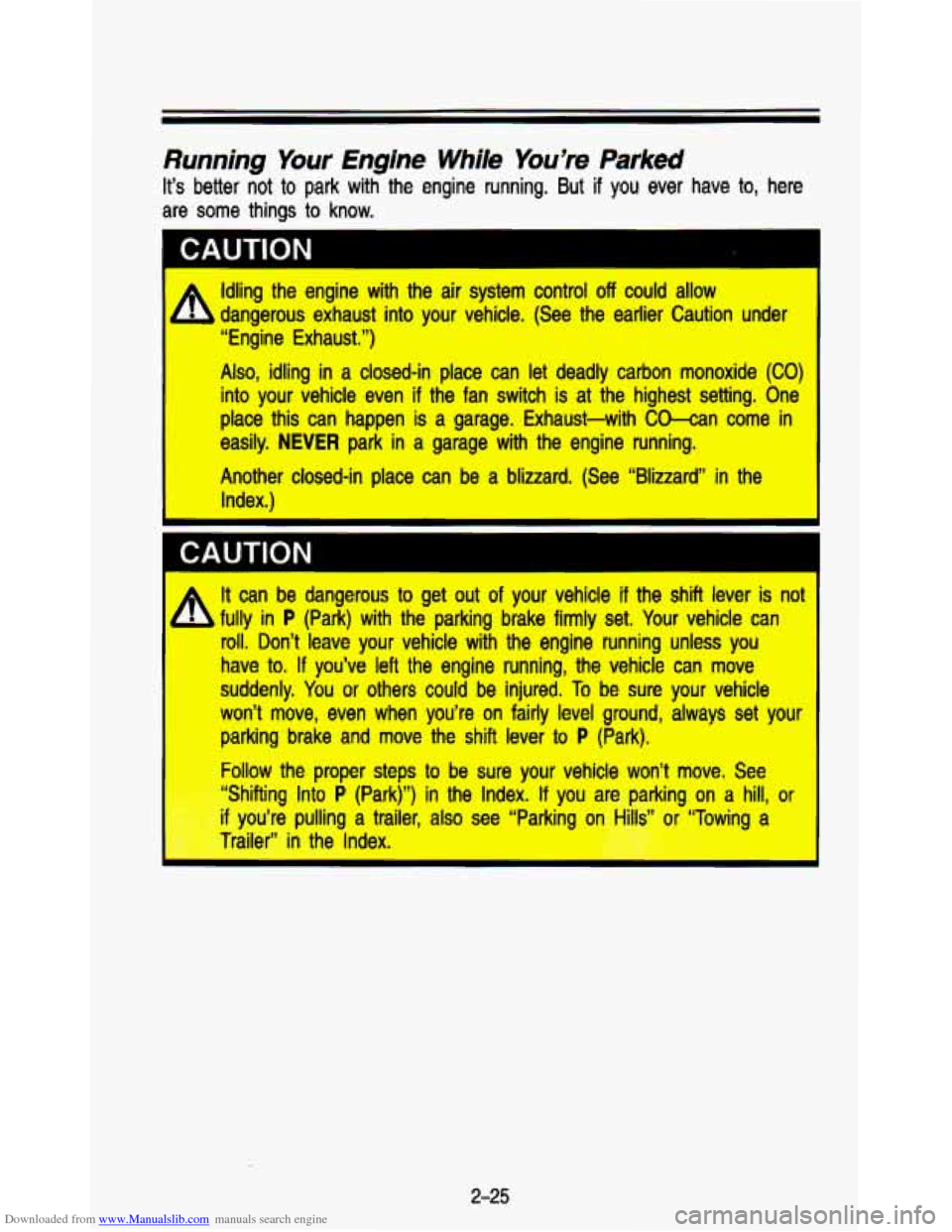
Downloaded from www.Manualslib.com manuals search engine Running Your Engine While You’re Parked
It’s better not to park with the engine running. But if you ever have to, here
are some things to know.
I CAUTION
A
Idling the engine with the air system control off could allow
dangerous exhaust into your vehicle. (See the earlier Caution under
“Engine Exhaust.”)
Also, idling in a closed-in place can let deadly carbon monoxide (CO)
into your vehicle even
if the fan switch is at the highest setting. One
place this can happen is a garage. Exhaust-with Ckan come in
easily.
NEVER park in a garage with the engine running.
Another closed-in place can be a blizzard. (See “Blizzard”\
in the Index.)
I CAUTION
r
A It can be dangerous to get out of your vehicle if the shift lever is not
h fully in P (Park) with the parking brake firmly set. Your vehicle can
roll. Don’t leave your vehicle with the engine running unles\
s you
have to.
If you’ve left the engine running, the vehicle can move
suddenly.
You or others could be injured. To be sure your vehicle
won’t move, even when you’re on fairly level ground, alwa\
ys set your parking brake and move the shift lever to
P (Park).
Follow the proper steps
to be sure your vehicle won’t move. See
“Shifting
Into P (Park)”) in the Index. If you are parking on a hill, or
if you’re pulling a trailer, also see “Parking on Hills” nr “Towing a
Trailer” in the Index.
2-25
Page 86 of 345

Downloaded from www.Manualslib.com manuals search engine Features & Controls
Turn Signal and Lane Change hdicator
The turn signal has two upward (for Right) and two downward \
(for Left)
positions. These positions allow you to signal a turn or a la\
ne change.
To signal a turn, move the lever all the way up or down. When the turn is
finished, the lever will return automatically.
A green arrow on the instrument panel will flash in the direction of the turn
or lane change.
To signal a lane change, just raise or lower the lever until the green arrow
starts to flash.
Hold it there until you complete your lane change. The lever
will return by itself when you release it.
As you signal a turn or a lane change, if the arrows don't flash but just stay
on, a signal bulb may be burned out and other drivers won't see your turn
signal.
If a bulb is burned out, replace it to help avoid an accident. If the green
arrows don't go on at all when you signal a turn, check the \
fuse (see "Fuses" in the Index) and for burned-out bulbs.
If you have a trailer towing option with added wiring for the tr\
ailer lights, a
different turn signal flasher is used. With this flasher installed, the signal
indicator will flash even
if a turn signal bulb is burned out. Check the front
and rear turn signal lights regularly to make sure they are working.
2-30
Page 123 of 345
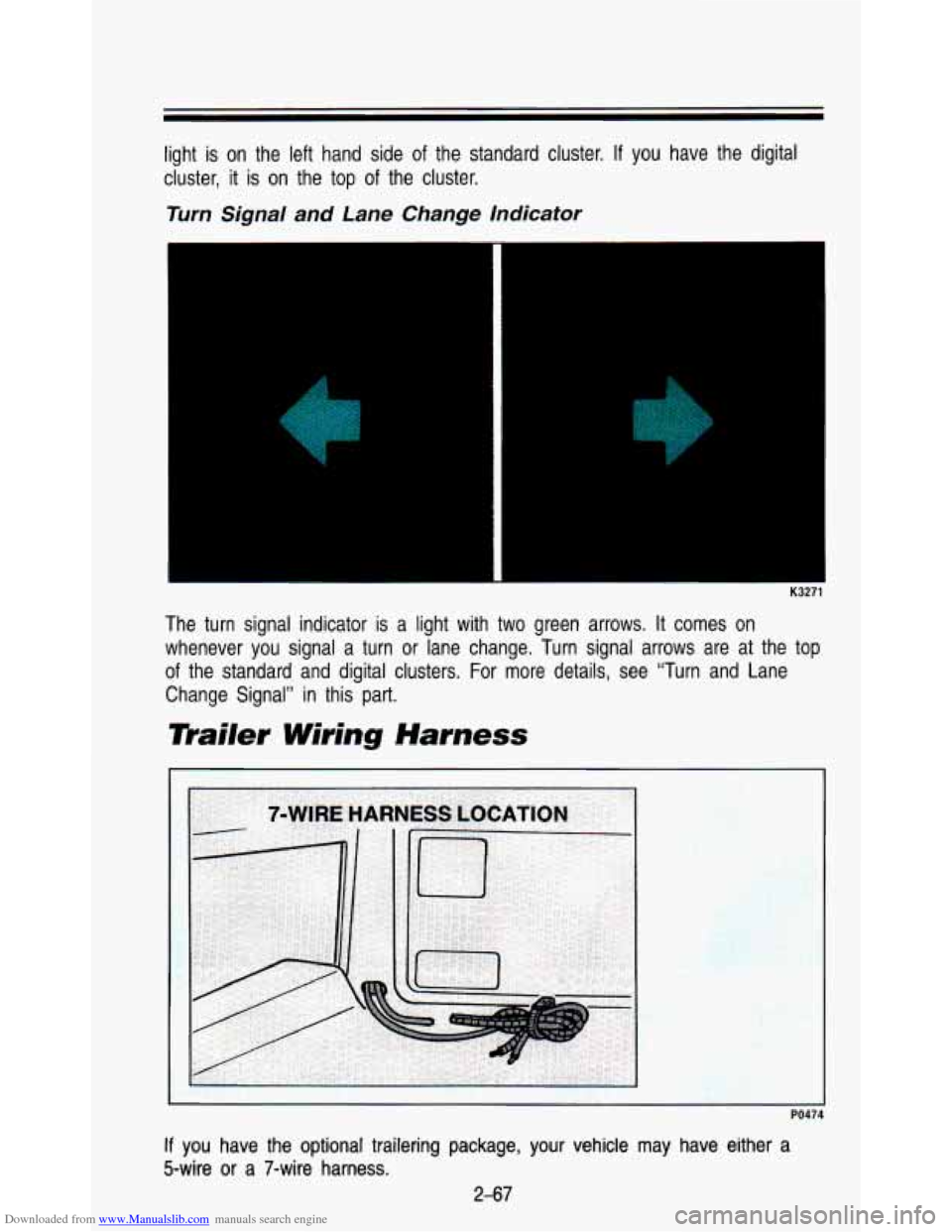
Downloaded from www.Manualslib.com manuals search engine light is on the left hand side of the standard cluster. If you have the digital
cluster, it
is on the top of the cluster.
Turn Signal and Lane Change Indicator
K3271
The turn signal indicator is a light with two green arrows. I\
t comes on
whenever you signal a turn or lane change. Turn signal arrows are at the top
of the standard and digital clusters. For more details, see “Tu\
rn and Lane
Change Signal” in this part.
mailer Wiring Harness
PO47
If you have the optional trailering package, your vehicle may have either a
5-wire or
a 7-wire harness.
2-67
Page 124 of 345

Downloaded from www.Manualslib.com manuals search engine Features & Contmls
The 5-wire harness is stored on the right side of the van near the rear wheel
well. The harness has no connector, and you should have a qua\
lified service
person wire your harness for you.
The harness must be routed out
of your vehicle between the rear door and the
floor, with enough of the harness
so that the trailer or the body won't pull it.
The 7-wire harness is stored on the right side of the van near the rear wheel
well. This harness has a
30 amp battery feed wire and no connector, and
should be wired by a qualified service person. Attach the harn\
ess
to the
trailer, then tape or strap
it to your vehicle's frame rail. Be sure you leave it
loose enough
so the wiring doesn't bend or break, but not so loose that it
drags on the ground.
The harness must be routed out
of your vehicle between the rear door and
the floor, with enough of the harness left on both sides
so that the trailer or
the body won't pull it.
Store the harness in its original place. Wrap the harness together and tie it
neatly
so it won't be damaged.
Assist Handles
If you have the optional rear hatch and split-panel doors, you will also
an assist handle on the inside hatch.
PO664
have
Assist handles are located on the inside front and center vehi\
cle pillars
Grasp them as necessary to help enter and exit your vehicle.
2-68